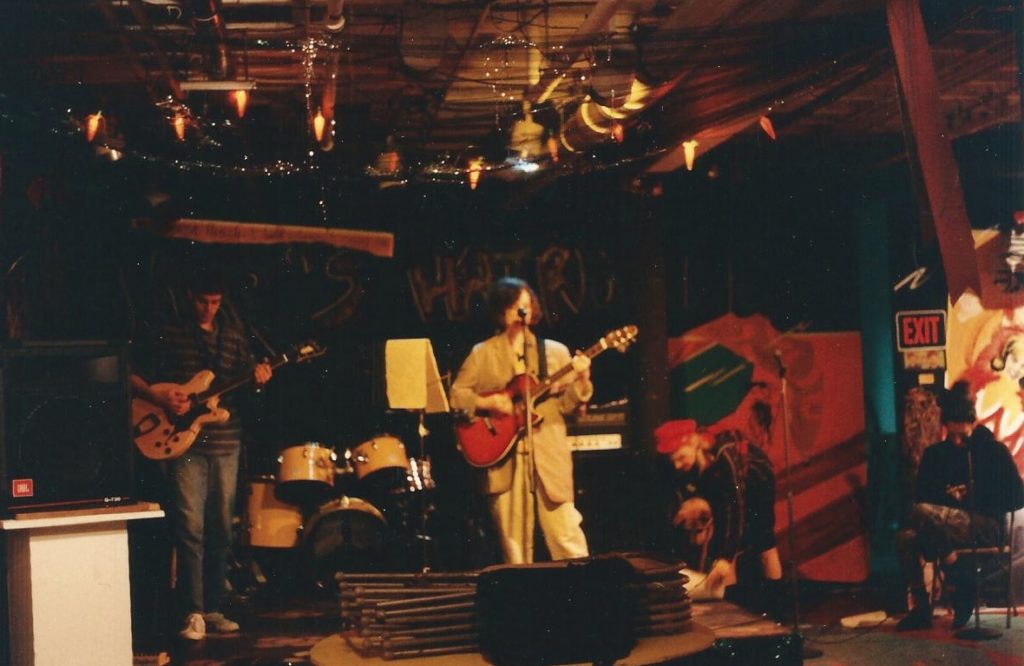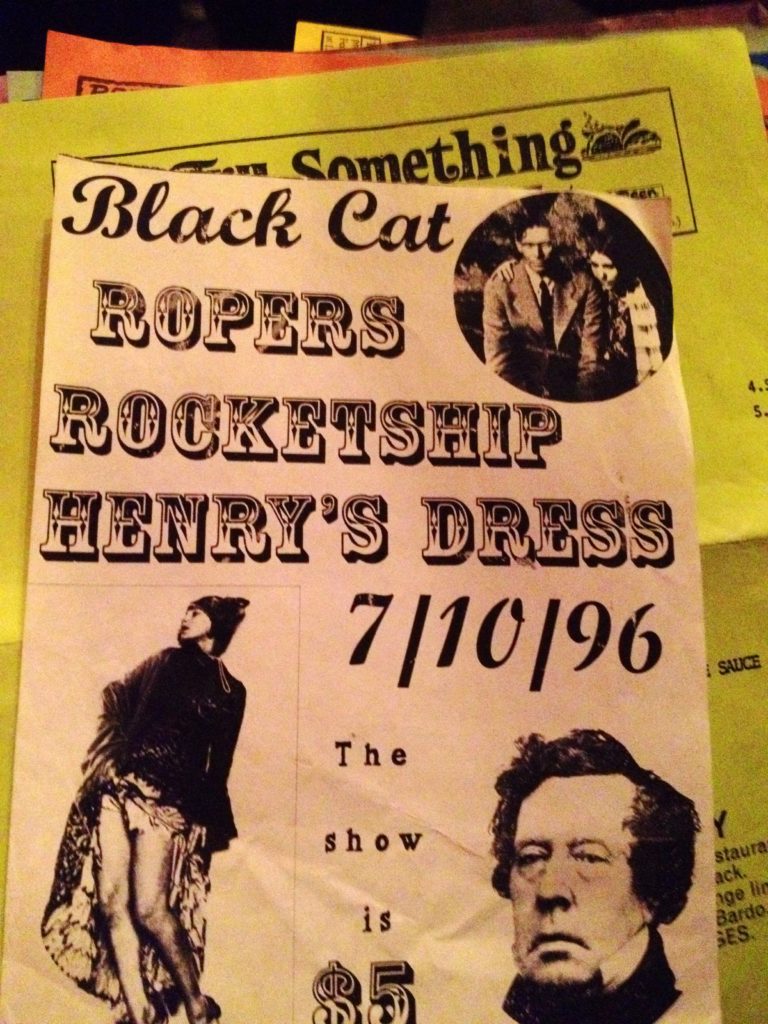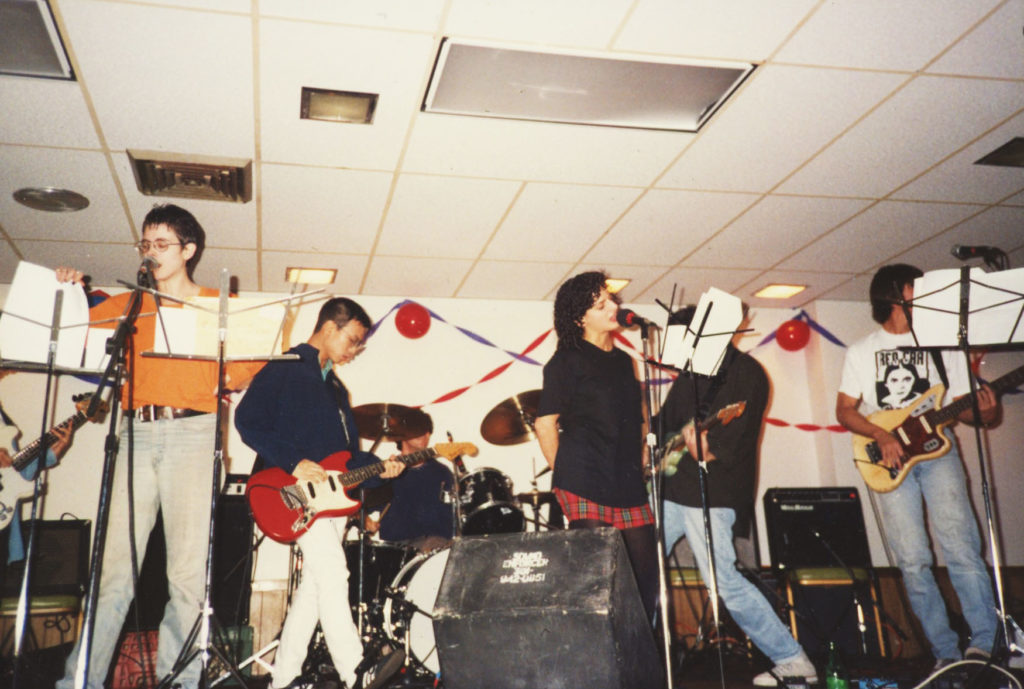
Certain artists take up too much space in the world, and some don’t take up enough. Baltimore’s Linda Smith falls into the latter camp. Keeping a low profile for decades, she started experimenting with a 4-track and putting down gentle home recordings in the early 1980s. Despite being on Slumberland, Shrimper, Feel Good All Over and Harriet, she didn’t capture (enough of) the public’s attention until releasing a comp called Till Another Time (1988-1996) on Captured Tracks in 2021. She’s also played in Silly Pillows and the Woods and was closely associated with the Magnetic Fields 30 years ago.

Folks who document discographies suggest she occupies similar territory to the Cannanes, Dump, Sentridoh, and the Marine Girls, so yeah, her music is right up (y)our alley. Now she has a great new record out with her old friend Nancy Andrews titled A Passing Cloud (2023). We caught up with her recently to see what’s happening in Charm City these days. (Listen to her music here.) Interview by Gail O / Images courtesy of Linda

chickfactor: How did your life change during the pandemic/lockdown?
Linda Smith: I had a year off of work. During this time, Captured Tracks released “Till Another Time”, a compilation of my old songs. I also started recording again after many years.
How did Baltimore change?
Like most cities, it became very quiet and deserted, with very little traffic on the streets.
What kind of impact did The Wire have on the city? Good or bad?
I never watched The Wire but it seems that people outside the city were influenced by it and took it as a realistic portrayal of the city. It reminds me of how people used to think of Baltimore as being like a John Waters movie. Certainly, there are aspects of truth in both but neither gives a complete picture.
How long have you lived there? Where else have you lived?
I was born here but I did live in NY City for 3 ½ years in the 1980s. When I moved to NY, it seemed to provide more action and excitement than Baltimore did. When I moved back, though, I was glad for the relative lack of excitement.
Were you musical as a child?
No, but after seeing the Beatles on Ed Sullivan, I wanted to be.

Were you from a musical family?
No, but we heard records frequently and I was given a transistor radio at the height of the 60’s pop music era.
What were you like as a teen?
I spent most of that phase listening to classical music and watching old movies, waiting for high school to end. While I loved AM radio in the 60’s, most of the music of the early 70’s seemed lackluster in comparison. It wasn’t until the late 70’s punk and New Wave period that I wanted to listen to rock and pop again.
I think I first heard your music on a cassette comp in about 1993 made by Keith Darcy. When did you first start making music?
Probably around 1979-80. I was buying a lot of records and became inspired by the Raincoats and Young Marble Giants, among others. I decided I wanted to be in a band like that and put an ad in the local free paper seeking other unschooled players. Many of those I met came from the art school (MICA), of course!

What have you learned about recording over the years? How has your process changed?
There are lots of technical aspects of recording that I have no idea about, but I learned enough to get individual tracks down on tape. For me, it was about keeping things simple. The recording process changed most recently when I started recording on my laptop. I thought it would be more difficult but it’s actually easier! In this case, I use the simplest program, Audacity.
What was the Baltimore music scene like when you were making music in the ’90s? And what’s it like now?
The music scene back then was more live performance and rock based, not so much about releasing recordings. These days, the scene is far more diverse. Musicians still play live but recorded music is very important to what they do. Bandcamp has allowed that to happen. A couple of years ago I put together a selection of current Baltimore music for The Lot radio in Brooklyn. There is so much going on that I wanted to include but couldn’t get everything in. It can be heard here: Listen to Baltimore to Brooklyn: Captured Tracks with Linda Smith @ The Lot Radio 06 – 17 – 2021 by The Lot Radio on #SoundCloud
You were working in the art world, yes? What is the art world like in Baltimore?
I worked in the security dept at the Baltimore Museum of Art for 15 years. The art world of the museum is a bit different from the art world on the outside of it. I was more involved with the former than the latter. In the security dept. one is somewhat invisible on a certain level but also privy to many things others never see. I could write a book.

Can you tell us some good stories about events that happened at the 14 Carat Cabaret?
Back in the 90’s, the 14K Cabaret was THE art scene in Baltimore. I did sound there for a year and saw many of the early shows. Laure Drogoul ran the Cabaret and always scheduled a mix of performance, music, and film. She booked many local artists as well as groups like Beat Happening, Scrawl, and the Magnetic Fields. The one night that really sticks out in my memory is the Annie Sprinkle performance. Packed house.

If I came to Baltimore for the day, what should I absolutely do?
Visit the art museums! Also, don’t miss Normals Books and Records for your music and literature needs. For small locally run shops and restaurants, I suggest Hampden.
Do you see John Waters around town much?
Not in general, but the museum where I worked had a show of his work a few years ago. We got to see him quite a bit then.
How does your songwriting process happen? Where do you write? What tools do you use?
My process is very tied to the recording process. Songs are often created while laying down tracks rather than fully written out beforehand. I’ve gotten more into making instrumental music, too. Writing lyrics has been of less interest to me recently but that could be old age.
Do you perform live much these days?
I’ve never performed all that often over the years but recently have received more requests to do so. With the release of my new album with Nancy Andrews, “A Passing Cloud” (Grapefruit/Gertude co-release), I’m thinking of becoming more involved in that aspect of music. We did a show last week at Normals Red Room, which was actually fun and not too nerve wracking!

Please tell us about the LD tribute record you have been working on.
One of the recording projects I started during the pandemic was prompted by LD Beghtol not long before he died suddenly. Though I did not know LD as well as those at Chickfactor (and elsewhere), we had communicated off and on since the 90’s, always with the idea of working on this or that project. In 2018, he created the cover for the Lost Sound Tapes Linda Smith tribute cassette, and also recorded a wonderful version of my song “Brightside”. When the shutdown happened in 2020, we were again in touch, this time about having me record one of his songs. He chose “Lack of Better”. I did my recording, which he was to add a vocal and acoustic guitar to but did not get the chance to do. Since then, the idea of an LD Beghtol tribute album has been germinating. He made so many connections with other musicians and wrote so many great songs, that it seems the best way to honor him. Many of the artists with whom he worked will be contributing tracks and Charles Newman at Motherwest is helping to organize it. (Thanks to Gail for the inside connections!)
What’s in your fridge? Can you cook? What is your specialty?
I like food that can be easily microwaved. 365 Plant based nuggets are a favorite. Other than that, I prefer to eat in restaurants but that gets expensive.
Do you have pets? Hobbies? Day job?
No pets, no day job (retired). Painting might be considered my hobby at this point; it has taken a back seat to music these days. I can only do one thing at a time, it seems.

What are you reading? Watching?
Too many books lying around here that need to be read but I just finished Celia Paul’s “Letters to Gwen John”, a collection of messages from a living painter to a long dead one. As for watching, I really like a good disaster movie, among other things. ☺
What’s on the turntable these days?
Since restarting my long dormant vinyl habit, there are brand new records along with interesting reissues of old music.
*Dottie Holmberg: Sometimes Happy Times (Sundazed)
*Wheatie Mattiasich: Old Glow (Open Mouth Records)
*Doug McKechnie: San Francisco Moog 1968-1972 (VG+ Records)
*The Smashing Times: Bloom (Meritorio Records)
*Tetsu Mineta: Early Scenes (Ditch Lily/Unread/Union Pole/Almost Halloween Time)
*Andre Previn: Dead Ringer Soundtrack (Warner Bros)
*Twink, The Best of: You Reached for the Stars (Sundazed)
*Josephine Foster: Godmother (Fire Records)
*Sarah La Puerta: Strange Paradise (Perpetual Doom)

Anything else you’d like to tell us about?
Besides the LD Beghtol tribute, I hope to do a vinyl re-release of the 1998 album I did with Paul Baroody, “Domesticated” (great pop songs with memorable melodies!), and a new album of poems by Baltimore writers set to music. Coming in 2023, there will be a full length album of old recordings by The Woods, my NY band in the 80’s, on Dot Matrix (a subsidiary of Sundazed/Modern Harmonic). In addition, Shrimper will be re-releasing my old Woods bandmate Brian Bendlin’s 1987 album, “13 Groves”, with artwork by me. Along the way, there are other various collaborations possible.
Much of my old music and all of my new music is available here: lindasmith2.bandcamp.com

Records Linda Smith cannot live without
*The Dionne Warwick Collection (Rhino)
*Lesley Gore: It’s My Party, The Mercury Anthology
*Sam Phillips: Martinis and Bikinis
*Brenda Holloway: The Motown Anthology
*The Shangri-Las: Shangri-Las 65
*Game Theory: Lolita Nation
*Young Marble Giants: Colossal Youth
*Four Tops Anthology
*Dolly Mixture Demo Tapes
*Sandy Denny: Who Knows Where the Time Goes? Collection



































